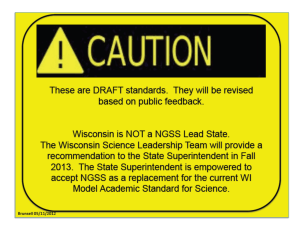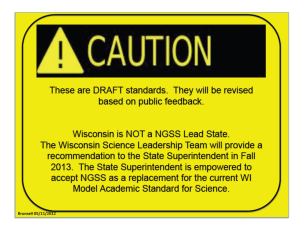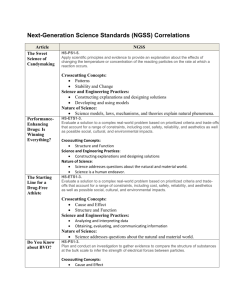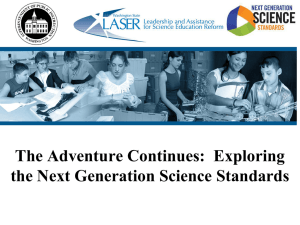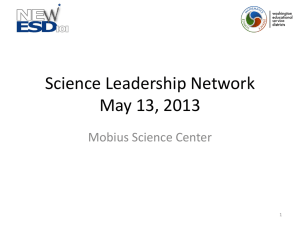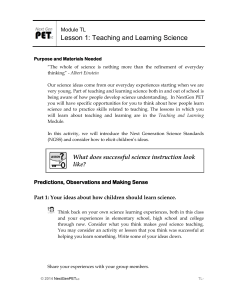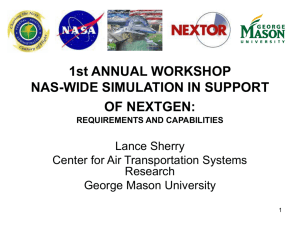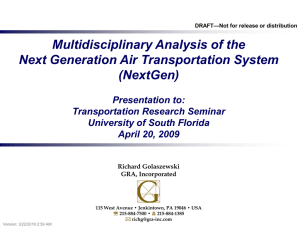Unit 1 Cycle 2: Interactions and Energy
advertisement
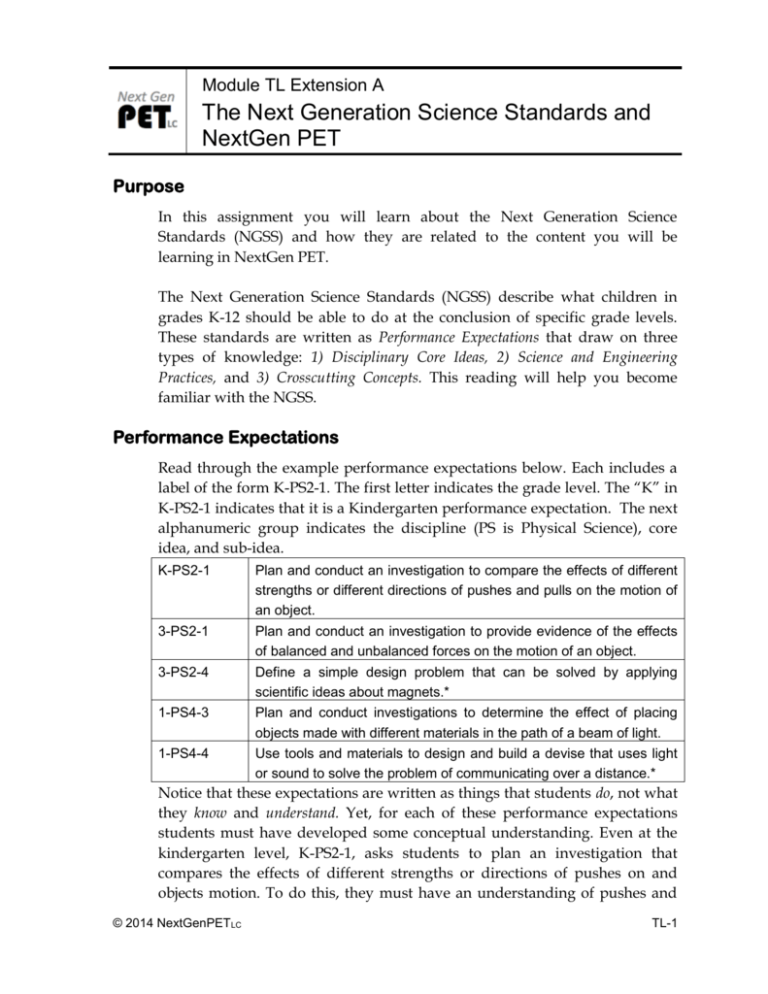
Module TL Extension A The Next Generation Science Standards and NextGen PET Purpose In this assignment you will learn about the Next Generation Science Standards (NGSS) and how they are related to the content you will be learning in NextGen PET. The Next Generation Science Standards (NGSS) describe what children in grades K-12 should be able to do at the conclusion of specific grade levels. These standards are written as Performance Expectations that draw on three types of knowledge: 1) Disciplinary Core Ideas, 2) Science and Engineering Practices, and 3) Crosscutting Concepts. This reading will help you become familiar with the NGSS. Performance Expectations Read through the example performance expectations below. Each includes a label of the form K-PS2-1. The first letter indicates the grade level. The “K” in K-PS2-1 indicates that it is a Kindergarten performance expectation. The next alphanumeric group indicates the discipline (PS is Physical Science), core idea, and sub-idea. K-PS2-1 3-PS2-1 3-PS2-4 1-PS4-3 1-PS4-4 Plan and conduct an investigation to compare the effects of different strengths or different directions of pushes and pulls on the motion of an object. Plan and conduct an investigation to provide evidence of the effects of balanced and unbalanced forces on the motion of an object. Define a simple design problem that can be solved by applying scientific ideas about magnets.* Plan and conduct investigations to determine the effect of placing objects made with different materials in the path of a beam of light. Use tools and materials to design and build a devise that uses light or sound to solve the problem of communicating over a distance.* Notice that these expectations are written as things that students do, not what they know and understand. Yet, for each of these performance expectations students must have developed some conceptual understanding. Even at the kindergarten level, K-PS2-1, asks students to plan an investigation that compares the effects of different strengths or directions of pushes on and objects motion. To do this, they must have an understanding of pushes and © 2014 NextGenPETLC TL-1 TL Extension A strength of pushes as well as the ways that an object might move in order to develop an appropriate test. Disciplinary Core Ideas There are four physical science ideas in the NGSS, each with 3-4 sub ideas: PS1. Matter and Its Interactions PS1A. Structure and Properties of matter PS1B. Chemical Reactions PS1C. Nuclear Processes PS2. Motion and Stability: Forces and Interactions PS2A. Forces and Motion PS2B. Types of Interactions PS2C. Stability and Instability in Physical Systems PS3. Energy PS3A. Definitions of Energy PS3B. Conservation of Energy and Energy Transfer PS3C. Relationships between Energy and Forces PS3D. Energy and Chemical Processes in Everyday Life PS4. Waves and Their Applications in Technology for Information Transfer PS4A. Wave Properties PS4B. Electromagnetic Radiation PS4C. Information Technologies and Instrumentation As you work through the activities and Modules in NextGen PET, you should be able to see how your work is related to the four large ideas above. Take a look at the table of contents for the module(s) you will be completing and try to match the disciplinary core ideas above with activities in NextGen PET that you anticipate will address these disciplinary core ideas. Science and Engineering Practices The Next Generation Science Standards (NGSS) describe eight practices of science and engineering. These are things that scientists and engineers do when they are doing science. The chart below (NRC, 2012) describes how the practices look in science and engineering. The goals of science and engineering are different. The goal of science is to explain natural phenomenon and to support these explanations with evidence. The goal of engineering is to identify problems that humans face and to solve these TL-2 The Next Generation Science Standards and NextGen PET problems through the invention and development of objects or processes. The processes by which these goals are met are similar. 1. 2. 3. 4. 5. 6. Asking questions (for science) and defining problems (for engineering). Developing and using models. Planning and carrying out investigations. Analyzing and interpreting data. Using mathematics and computational thinking. Constructing explanations (for science) and designing solutions (for engineering). 7. Engaging in argument from evidence. 8. Obtaining, evaluating, and communicating information. NextGen PET is designed so that as you learn about physics and chemistry in this course, you will also be engaging in some of the science and engineering practices. Some of these practices will be used throughout the entire course and others you will see used in a more focused way in specific modules. Crosscutting Concepts The third strand of the Next Generation Science Standards are crosscutting concepts. These are ideas that bridge the science disciplines. While we do not explicitly focus on crosscutting concepts in NextGen PET, you may notice that the ideas come up in both the Physics and Chemistry Modules. There are seven crosscutting concepts: 1. 2. 3. 4. 5. 6. 7. Patterns Cause and Effect: Mechanism and explanation, Scale, proportion, and quantity, Systems and system models, Energy and matter: Flows, cycles, and conservation Structure and function, and Stability and change. References National Research Council. (2012). A Framework for K-12 Science Education: Practices, Crosscutting Concepts, and Core Ideas. Washington, DC: The National Academies Press. Achieve (2012). Next Generation Science Standards. Available at http://www.nextgenscience.org/ TL-3
